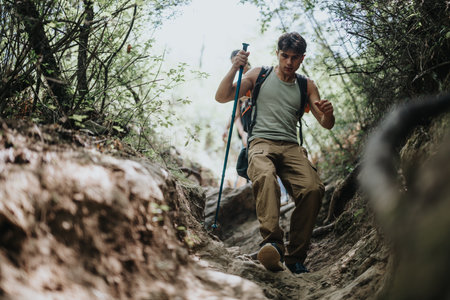1. The Spirit of Trail Stewardship
Trail stewardship is at the heart of America’s outdoor culture. Across the United States, hikers aren’t just visitors to beautiful landscapes—they see themselves as caretakers of the land. This deep-rooted sense of responsibility comes from a long tradition of respecting public lands and wild places. Whether hiking in the Rockies, the Appalachians, or local state parks, American hikers know that their actions today shape these trails for generations to come.
What Does Trail Stewardship Mean?
Trail stewardship goes beyond simply following trail rules. It’s about actively protecting nature, maintaining paths, and ensuring wildlife habitats remain undisturbed. For many, it means volunteering for trail maintenance days, picking up litter along the way, or educating others about Leave No Trace principles.
Key Principles of U.S. Trail Stewardship
| Principle | Description |
|---|---|
| Leave No Trace | Packing out all trash, minimizing campfire impact, and staying on marked trails |
| Respect Wildlife | Observing animals from a distance and not feeding them |
| Volunteerism | Joining trail work crews and participating in clean-up events |
| Education & Advocacy | Teaching others about sustainable hiking practices and supporting conservation policies |
The American Outdoor Ethic in Action
Hikers across the country take pride in being stewards of their favorite trails. Community-led groups organize regular clean-ups and restoration projects, while individuals make small but meaningful choices each time they hit the trail. This spirit of stewardship keeps America’s wild spaces open and thriving—not only for today’s adventurers but for everyone who will follow in their footsteps.
2. Leave No Trace Principles in Action
What Does “Leave No Trace” Mean?
For hikers across the United States, “Leave No Trace” isn’t just a slogan—it’s a way of life on the trail. This set of seven principles helps everyone enjoy nature while keeping it wild and beautiful for future generations. Following these guidelines means respecting the land, wildlife, and fellow adventurers. Let’s break down how U.S. hikers put these values into action every day.
The Seven Principles Made Simple
| Principle | Everyday Actions |
|---|---|
| Plan Ahead and Prepare | Check weather, know local rules, pack only what you need, and bring reusable gear. |
| Travel and Camp on Durable Surfaces | Stick to marked trails, use established campsites, and avoid trampling plants. |
| Dispose of Waste Properly | Pack out all trash—even fruit peels—and use restrooms or dig small holes for waste. |
| Leave What You Find | Avoid picking flowers, taking rocks, or disturbing historic sites. |
| Minimize Campfire Impact | Use camp stoves instead of making fires; if fires are allowed, keep them small and use existing fire rings. |
| Respect Wildlife | Observe animals from a distance, never feed them, and store food securely. |
| Be Considerate of Others | Keep noise down, yield to other trail users, and greet people with a friendly hello. |
Practical Habits for Every Hiker
On trails from the Appalachian Mountains to Yosemite, hikers practice stewardship by picking up litter (even if it’s not theirs), staying on paths to prevent erosion, and packing out everything they brought in. Many carry a small trash bag or ziplock in their backpack for wrappers or micro-trash. Some even join volunteer days to repair trails or educate new hikers about Leave No Trace ethics.
Cultural Values: Trail Etiquette in the U.S.
Respect is at the heart of American hiking culture. On busy trails, you’ll often hear hikers say “on your left” when passing or offer a smile and nod as they step aside for others. Dog owners leash their pets and pick up after them. Groups yield to solo hikers or those moving uphill. All these habits help keep natural spaces welcoming for everyone—today and for years to come.

3. Volunteerism and Community Involvement
Across the United States, hikers play a vital role in protecting and preserving trails through active volunteerism and strong community spirit. Many Americans step up to help keep the trails beautiful, safe, and accessible for everyone. Here’s how hikers get involved:
Trail Maintenance Days
One of the most popular ways hikers give back is by joining trail maintenance days. These events are often organized by local hiking clubs or land management agencies. Volunteers might clear fallen branches, repair erosion, repaint trail markers, or pick up litter. Whether you’re an experienced outdoors enthusiast or just starting out, there’s always a job for everyone. Participating in these events fosters teamwork and helps people feel directly connected to the places they love.
What Happens on a Trail Maintenance Day?
| Activity | Description | Who Can Join? |
|---|---|---|
| Clearing Debris | Removing branches, rocks, and trash from trails | All ages, no experience needed |
| Fixing Erosion | Building water bars or steps to prevent washouts | Adults and teens; some training provided |
| Patching Trail Signs | Repainting or replacing faded signs and blazes | Anyone who can handle simple tools |
| Invasive Plant Removal | Pulling weeds that threaten native plants | Youth groups, families, individuals welcome |
Joining Conservation Organizations
Many U.S. hikers become members of conservation groups like the American Hiking Society, Appalachian Trail Conservancy, or local “Friends of the Trail” organizations. These groups provide resources, organize events, and advocate for public lands. By joining, hikers support larger efforts to preserve nature and often receive opportunities for education and hands-on involvement.
Popular Conservation Groups for Hikers:
- American Hiking Society: Advocates for trails nationwide and hosts National Trails Day each June.
- Pacific Crest Trail Association: Protects one of America’s iconic long-distance trails.
- Sierra Club: Runs local outings and works on broader environmental campaigns.
- Your Local Trail Crew: Nearly every state has local volunteer groups working on nearby trails.
A Culture of Collective Stewardship
The American hiking community believes in “leaving it better than you found it.” This ethic is passed down to new generations through group hikes, youth programs, and social media campaigns that encourage stewardship as a shared responsibility. Hikers often say that when you protect a trail together, you build friendships and memories that last a lifetime—while ensuring wild places will be there for those who follow.
4. Education and Inspiring the Next Generation
Mentoring Young Hikers on Outdoor Ethics
One of the most important ways U.S. hikers protect trails is by passing on outdoor ethics to youth and newcomers. Experienced hikers take pride in teaching younger generations how to care for nature, follow Leave No Trace principles, and respect wildlife and fellow trail users. Many hiking clubs and organizations offer mentorship programs where experienced volunteers guide kids and new hikers during organized outings. These mentors explain why it’s important to stay on designated paths, pack out trash, and leave natural things undisturbed.
Programs and Initiatives for Youth Outreach
Across the United States, there are many programs focused on introducing kids to hiking and stewardship. Groups like the American Hiking Society, local trail coalitions, and scout troops run workshops at schools or community centers. Summer camps often include classes about environmental responsibility alongside fun hikes. These efforts help create a sense of responsibility early on, so young people grow up with respect for the outdoors.
Common Trail Stewardship Programs
| Program Name | Main Activities | Target Audience |
|---|---|---|
| Junior Ranger Program (National Parks) | Hands-on learning, trail cleanups, badge earning | Children & Families |
| Leave No Trace Youth Outreach | Ethics education, interactive games, field trips | K-12 Students |
| Trail Crew Volunteer Days | Trail maintenance, habitat restoration | Teens & Young Adults |
| Scout Environmental Badges | Service projects, outdoor skills training | Boys & Girls Scouts |
The Power of Peer Learning and Community Events
Youth often learn best from seeing others in action. Community events like group hikes, trail days, or outdoor festivals provide opportunities for newcomers to see stewardship firsthand. During these events, veteran hikers demonstrate practical skills such as cleaning up litter or fixing trail markers. This hands-on approach helps make stewardship feel like a normal part of enjoying the outdoors.
Mentality Shift: From Visitor to Caretaker
The goal is to inspire young people and new hikers to move beyond just being visitors in nature. By learning directly from mentors and participating in outreach programs, they become caretakers—people who look after the land for everyone’s benefit now and into the future.
5. Facing Modern Challenges Together
America’s trails are more popular than ever, but this growing love for hiking brings new challenges. From crowded paths to unpredictable weather and shrinking natural resources, today’s hikers face a changing world. Here’s how trail stewards across the U.S. are teaming up to protect our beloved outdoor spaces for future generations.
Ongoing Threats to Our Trails
| Threat | What It Means | How Hikers Respond |
|---|---|---|
| Increased Usage | More people on trails can lead to erosion, litter, and habitat disruption. | Hikers join volunteer cleanups, follow Leave No Trace principles, and report issues to park rangers. |
| Climate Change | Unpredictable weather, wildfires, and invasive species threaten trail ecosystems. | Groups organize tree-planting days, monitor trail conditions, and support climate-resilient projects. |
| Resource Depletion | Lack of funding and staff means less maintenance for trails and facilities. | Local hiking clubs raise funds, adopt-a-trail programs offer hands-on help, and hikers advocate for public lands funding. |
Working Together for Sustainable Solutions
The American hiking community understands that protecting nature is a shared responsibility. Trail stewardship groups—like the Pacific Crest Trail Association or Appalachian Trail Conservancy—bring together volunteers from all walks of life. These groups:
- Host workshops: Teaching everything from trail repair to wildlife safety.
- Create partnerships: Working with local businesses and schools to spread awareness.
- Encourage reporting: Using apps or hotlines so hikers can quickly flag problems like downed trees or washouts.
- Promote inclusivity: Welcoming diverse voices ensures everyone feels part of the solution.
The Power of Community Action
No one can protect America’s trails alone. By coming together, hikers build stronger, more resilient outdoor spaces. Whether you’re picking up trash on a weekend hike or joining a statewide advocacy campaign, every action counts toward keeping our trails wild and wonderful for tomorrow’s explorers.


